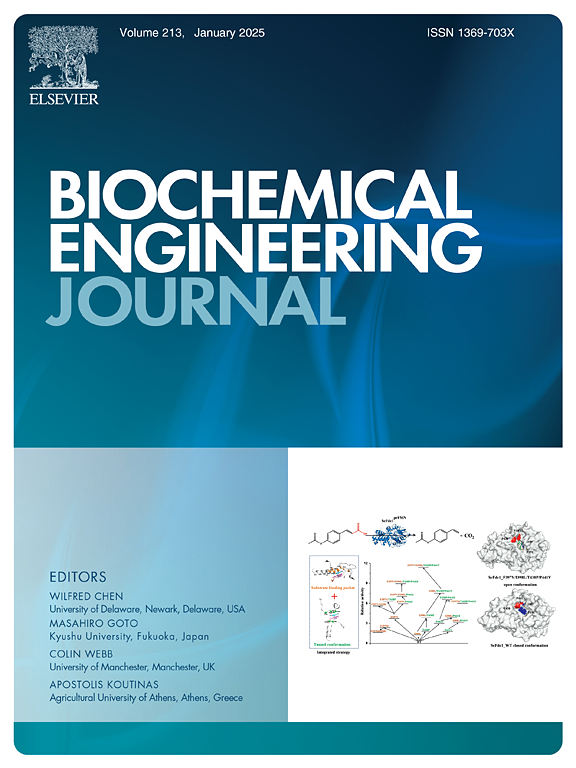无机械曝气连续流藻菌颗粒污泥生物反应器处理循环水养殖废水的可行性
IF 3.7
3区 生物学
Q2 BIOTECHNOLOGY & APPLIED MICROBIOLOGY
引用次数: 0
摘要
循环水养殖系统(RAS)可以在先进和可控的环境中实现高密度的水生动物生产。然而,由于资源/运行成本高,难以保持稳定的水质,特别是氨和亚硝酸盐的控制,其应用仍然受到限制。将藻类-细菌好氧颗粒污泥(AGS)整合到RAS中可能有助于减少曝气需求,同时实现C/N/P的管理和回收。然而,它在RAS连续流反应器中的应用在很大程度上仍未被探索。本研究首次建立了无机械曝气的藻-细菌AGS连续流反应器作为RAS的生物处理组件。该生物反应器表现出优异的日NH4+ -N去除率,为17-31 mg/g-VSS(挥发性悬浮固体),在整个试验周期内,每个循环4 min去除率为 77 %,运行18 d后去除率为 90 %,N回收率为28 %。这一观察结果最初主要归因于硝化/反硝化作用,随后转变为藻类同化的主要脱氮机制。此外,不需要外部机械曝气,因为光合作用和水湍流可以维持高溶解氧水平,大大降低了能量需求。颗粒结构稳定性好,完整性系数<; 20 %,沉降性好。这些结果表明,所提出的连续流藻-细菌AGS生物反应器是一种有前途的可持续水产养殖业解决方案。本文章由计算机程序翻译,如有差异,请以英文原文为准。
Feasibility of continuous-flow algal-bacterial granular sludge bioreactor with no mechanical aeration for recirculating aquaculture wastewater treatment
Recirculating aquaculture system (RAS) can achieve high-density aquatic animal production in advanced and controlled environments. However, its application is still limited due to high resource/operation costs and difficulty in maintaining stable water quality, particularly ammonia and nitrite control. Integrating algal-bacterial aerobic granular sludge (AGS) into RAS may help reduce aeration demand and enable simultaneous C/N/P management and recovery. However, its application in continuous-flow reactors for RAS remains largely unexplored. In this study, a continuous-flow reactor with algal-bacterial AGS and no mechanical aeration was first established as the biological treatment component of RAS. The bioreactor demonstrated an excellent daily NH4+ -N removal capacity of 17–31 mg/g-VSS (volatile suspended solids) with > 77 % of total inorganic nitrogen removal in 4 min per cycle during the whole test period and > 90 % after 18 days’ operation in addition to 28 % N recovery. This observation was initially attributed primarily to nitrification/denitrification and subsequently transitioned to algal assimilation regarding the dominant N removal mechanism. Moreover, no external mechanical aeration was required, since high dissolved oxygen levels can be maintained by photosynthesis and water turbulence, greatly lowering energy demands. The granules also reflected strong structural stability with integrity coefficient < 20 % and good settleability. These results suggest that the proposed continuous-flow algal-bacterial AGS bioreactor is a promising solution for sustainable aquaculture industry.
求助全文
通过发布文献求助,成功后即可免费获取论文全文。
去求助
来源期刊

Biochemical Engineering Journal
工程技术-工程:化工
CiteScore
7.10
自引率
5.10%
发文量
380
审稿时长
34 days
期刊介绍:
The Biochemical Engineering Journal aims to promote progress in the crucial chemical engineering aspects of the development of biological processes associated with everything from raw materials preparation to product recovery relevant to industries as diverse as medical/healthcare, industrial biotechnology, and environmental biotechnology.
The Journal welcomes full length original research papers, short communications, and review papers* in the following research fields:
Biocatalysis (enzyme or microbial) and biotransformations, including immobilized biocatalyst preparation and kinetics
Biosensors and Biodevices including biofabrication and novel fuel cell development
Bioseparations including scale-up and protein refolding/renaturation
Environmental Bioengineering including bioconversion, bioremediation, and microbial fuel cells
Bioreactor Systems including characterization, optimization and scale-up
Bioresources and Biorefinery Engineering including biomass conversion, biofuels, bioenergy, and optimization
Industrial Biotechnology including specialty chemicals, platform chemicals and neutraceuticals
Biomaterials and Tissue Engineering including bioartificial organs, cell encapsulation, and controlled release
Cell Culture Engineering (plant, animal or insect cells) including viral vectors, monoclonal antibodies, recombinant proteins, vaccines, and secondary metabolites
Cell Therapies and Stem Cells including pluripotent, mesenchymal and hematopoietic stem cells; immunotherapies; tissue-specific differentiation; and cryopreservation
Metabolic Engineering, Systems and Synthetic Biology including OMICS, bioinformatics, in silico biology, and metabolic flux analysis
Protein Engineering including enzyme engineering and directed evolution.
 求助内容:
求助内容: 应助结果提醒方式:
应助结果提醒方式:


